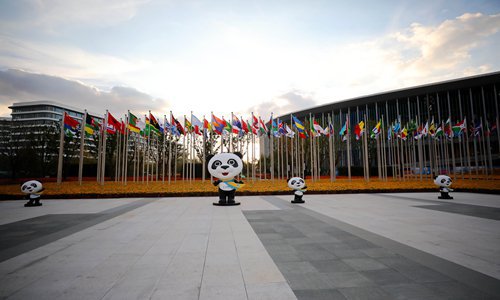HOME >> BUSINESS
CIIE creates more chances for enhanced China-LatAm cooperation
By Xinhua - Global Times Source:Global Times - Xinhua Published: 2019/10/14 18:53:39

Flags of different countries and regions stand at a square of the CIIE venue National Exhibition and Convention Center(Shanghai) Photo: Yang Hui/GT
The upcoming second China International Import Expo (CIIE) creates new chances for Latin American countries to share in the growing Chinese market, said exporters and scholars across the region.
The CIIE provides an ideal venue for global exporters keen to trade with China, offering a valuable opportunity for countries like Chile to get to know more about China and to learn about what products Chinese consumers could be interested in, said Chilean economist Manuel Agosin.
The trade relationship with China is extraordinarily important to Chile, and the more Chinese companies that know about available Chilean products, the better, said Agosin.
In recent years, Chile has seen decisive growth in certain productive sectors, such as copper mining and fruit farming, and much of that "is due to its exports to China," said Agosin.
Cheese bread, Brazil's favorite breakfast and snack food, is now available at Chinese cafeterias, thanks to the first CIIE in Shanghai last year.
In May, Brazil's leading cheese bread maker Forno de Minas shipped its first container of 10 tons of cheese bread to China, supplying cafeterias in Shanghai. Two months later, the bakery made a second shipment to China with 18 tons of cheese bread in July.
"We are proud to have arrived in China," Gabriela Cioba, manager of foreign trade at Forno de Minas, told the Xinhua News Agency.
Forno de Minas had already been exporting cheese bread to 17 countries before it decided to tackle the Chinese market in 2018 by participating in the CIIE.
Events such as the CIIE are crucial to exporters, said Cioba.
Meanwhile, countries across Latin America are vying to attract more Chinese tourists as the Asian country now boasts the world's leading source of outbound tourism.
Uruguay's Deputy Minister of Tourism Benjamin Liberoff said the country is preparing to promote itself as a tourist destination at the second CIIE, which is to be held in Shanghai in November.
"Uruguay is sending a delegation there," said Liberoff.
For El Salvador, which established diplomatic ties with China last year, has seen a robust growth in its exports to China, with coffee topping the list.
Ever since the two countries established diplomatic ties on August 21, 2018, China has been actively developing the relationship based on mutual respect, shared benefits, equal footing and non-intervention in each other's internal affairs, said China's Ambassador to El Salvador Ou Jianhong.
In August, the first shipments of Salvadoran coffee made their way to China through direct export.
China has attached great importance to agricultural cooperation with El Salvador in developing bilateral ties, said Ou.
Ou said that she hopes Salvadoran businesspeople can make full use of the second CIIE, to present their products to Chinese buyers.
China-Latin America cooperation, built on the basis of equality, has been beneficial for both sides and helpful in boosting multilateralism, Argentine economist and China expert Gonzalo Tordini said.
"Our region gives strategic importance to the relationship with China. This is demonstrated by the agreements that most Latin American countries have reached with China," the expert said during an interview with Xinhua.
"The relationship has developed not only at the investment and trade levels, but also in the fields of culture, sports, education, tourism, science and technology," said Tordini, head of educational affairs at the Latin American Center on Chinese Political and Economic Studies.
China has become the second-largest trading partner of Latin America, while the latter is one of the fastest-growing regions in terms of exports to China. Two-way trade rose 18.9 percent year-on-year to reach $307.4 billion in 2018, according to China's official data.
Posted in: ECONOMY